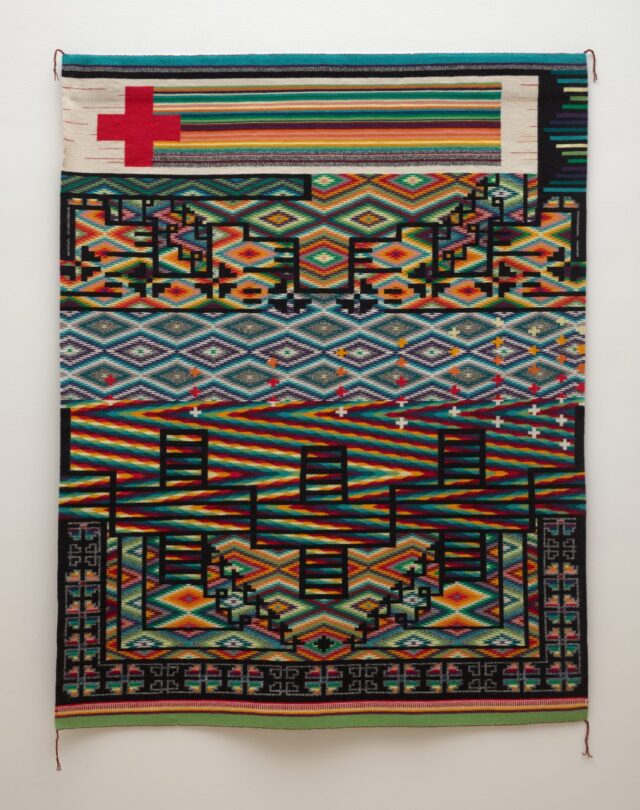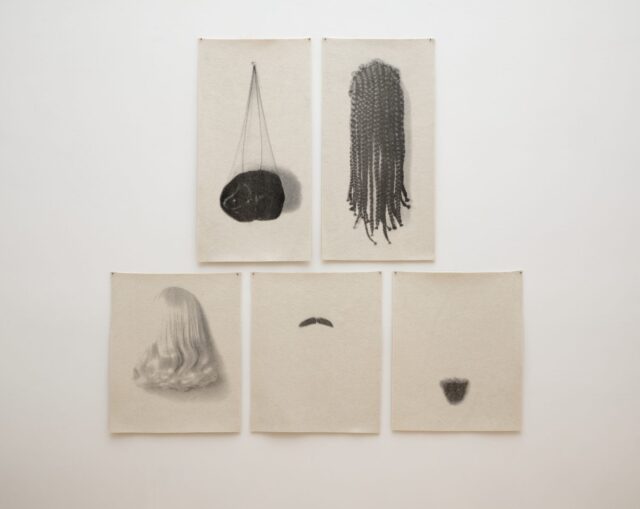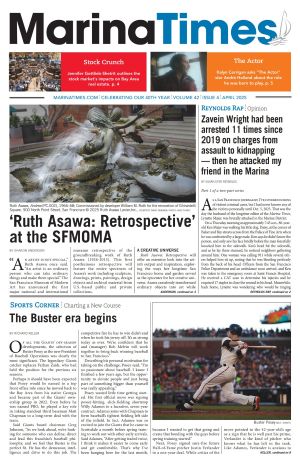The San Francisco Museum of Modern Art has acquired new works over the last six months, including innovative photo-based and video artworks. Works on paper, paintings, sculpture, design and architecture are included as well as contemporary art drawing on craft traditions.
Amidst this wide range of artworks are paintings and works on paper by Paul Chan, Kenturah Davis, Sollee Darell, Jean LaMarr, Frank LaPena, Linda Lomahaftewa, Richard Mayhew, Peter Sacks, Kandis Williams and Takako Yamaguchi; sculpture and mixed-media works by Emanoel Araujo, Candice Lin, and Daniel Lind-Ramos; architecture and design works, photography from artists including Catherine Opie, video film and media artworks by Oscar Munoz, Samson Young and a work by Steve McQueen.
Melissa Cody, Dopamine Regression (2010)

Melissa Cody reclaims Navajo/Diné imagery and tradition in her textiles. The Navajo/Diné patterns are woven into sophisticated geometric overlays and color schemes that bridge visual languages from 1980s video games to Germantown Revival weaving. Dopamine Regression is an early weaving reflecting on her father’s battle with Parkinson’s disease. A large red cross at the top left corner represents both the medical field and the figure of Spider Woman who taught the art of weaving in Navajo/Diné cosmovision. From this area, beams of rainbow rays spread over stacked, patterned fields. Zigzags resembling brain wave scans mix with serrated diamond shapes in a contrast between digital imagery and traditional forms. Cody is a fourth-generation weaver and an enrolled member of the Navajo Nation. Dopamine Regression is the first work by Cody to enter SFMOMA’s collection.
Lorna Simpson, Wigs (New Museum Configuration) (1994)

Lorna Simpson is an American photographer who uses images of hair to explore themes of gendered and racialized sight, power and negation. As a conceptual artist, she began in the early 1990s to substitute the body with symbolic stand-ins. Wigs comprises a series of five waterless lithographs on felt, the texture of which references the look of hair. A floating moustache is a stand-in for a figure facing forward, as is the triangle of pubic hair at the bottom of one lithograph, and the back of a head — again, represented by hair — suggests a figure walking away. Wigs expands the museum’s holdings of Simpson’s early work, and is indicative of SFMOMA’s continuing efforts to acquire innovative pieces.
Al Wong, Twin Peaks (1977)
Twin Peaks is the first work by San Francisco artist AI Wong to enter SFMOMA’s collection. Seldom seen, Twin Peaks was filmed over the course of a year in Twin Peaks in San Francisco during varying times of the day. Wong’s camera is set inside the car as he drives through the hypnotic figure-eight road that winds around the area. During one part of the 50-minute film, the image splits in half and becomes out of synch, a reference to the illusory nature of reality. Zen Buddhist philosophy informs Wong’s works referencing endless cycles and the deceptive nature of the material world. Recently restored in 16mm, the work is being presented for the first time on a digital LED screen on SFMOMA’s Floor 1 through summer 2026. Wong is an alumnus of the San Francisco Art Institute, where he was a longtime faculty member.
These acquisitions continue SFMOMA’s ongoing efforts to expand on what contemporary art includes, and its role in our time. Christopher Bedford, SFMOMA’s Helen and Charles Schwab Director, says, “Our curators have deeply researched artworks and under-recognized artists from around the world and Northern California to identify works of art that are meaningful for our audiences and can speak to new ways of telling the history of art.”
SFMOMA is located at 151 3rd St.
Sharon Anderson is an artist and writer in Southern California. She can be reached at mindtheimage.com




